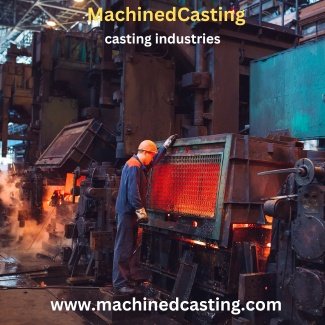Casting is a vital process in manufacturing industries, utilized to create intricate shapes and designs for various applications. From automotive parts to sculptures, the casting process plays a pivotal role in bringing ideas to reality. This guide aims to provide a comprehensive overview of casting industries, covering different casting methods, materials, applications, and advancements in the field.
Types of Casting Processes:
- Sand Casting: One of the oldest and most widely used casting methods, sand casting involves creating a mold from compacted sand and then pouring molten metal into it. It's suitable for producing large parts with complex geometries.
- Investment Casting: Also known as lost-wax casting, investment casting involves creating a wax pattern, encasing it in a ceramic mold, and then melting the wax to leave a cavity for molten metal. This process is ideal for producing intricate and high-precision parts.
- Die Casting: Die casting utilizes reusable metal molds, called dies, to produce parts with high accuracy and surface finish. Molten metal is injected into the dies under high pressure, making it suitable for mass production of small to medium-sized parts.
- Permanent Mold Casting: This method involves using permanent molds made from metal to cast molten metal. It offers higher dimensional accuracy and surface finish compared to sand casting and is often used for casting aluminum and magnesium alloys.
- Centrifugal Casting: In centrifugal casting, molten metal is poured into a spinning mold, resulting in parts with uniform density and improved mechanical properties. It's commonly used for producing cylindrical shapes such as pipes and tubes.
Materials Used in Casting:
- Ferrous Metals: Cast iron and steel are commonly used in casting due to their excellent mechanical properties and versatility.
- Non-Ferrous Metals: Aluminum, copper, and zinc alloys are frequently casted for their lightweight, corrosion resistance, and conductivity properties.
- Exotic Alloys: In specialized applications, alloys like titanium and nickel-based superalloys are used for their high strength, heat resistance, and chemical stability.
Applications of Casting:
- Automotive Industry: Engine blocks, cylinder heads, transmission components, and various other parts are produced using casting methods.
- Aerospace Industry: Aircraft components, such as turbine blades, structural parts, and landing gear components, are often manufactured through casting.
- Art and Sculpture: Casting allows artists to create intricate sculptures and artworks in various metals, preserving fine details and textures.
- Medical Equipment: Components for medical devices, implants, and prosthetics are manufactured using casting methods for their precision and biocompatibility.
- Industrial Machinery: Casting is integral to producing components for heavy machinery, pumps, valves, and other industrial equipment.
Advancements and Innovations:
- Additive Manufacturing: 3D printing technologies are revolutionizing casting industries by enabling the production of complex molds and patterns with reduced lead times and costs.
- Simulation Software: Advanced computer simulations allow engineers to optimize casting processes, predict defects, and improve part quality before actual production.
- Sustainable Practices: Efforts are being made to minimize waste and energy consumption in casting industries through recycling, waste reduction, and use of eco-friendly materials.
Conclusion: Casting industries play a crucial role in manufacturing diverse products across various sectors. By understanding the different casting processes, materials, applications, and embracing technological advancements, manufacturers can achieve greater efficiency, quality, and sustainability in their casting operations.


No comments yet